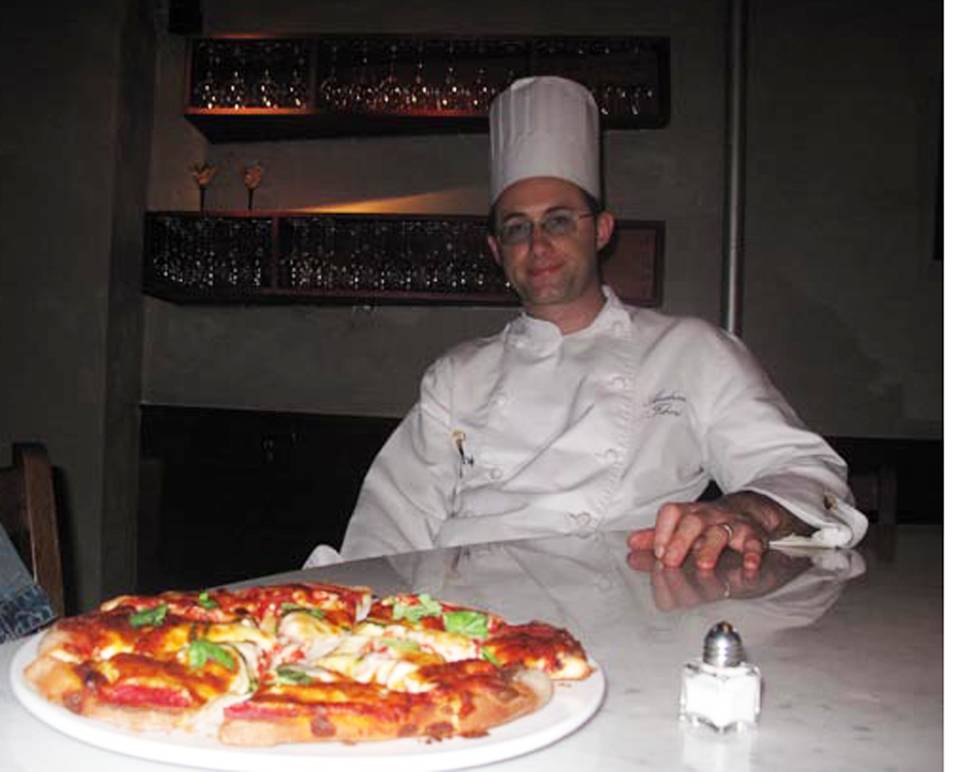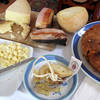2000 Pounds of Italian Fish. “Eatalian Style” at ILICA’s 5th Annual Conference
If you happen to hit “Cellar 58” in the next few days, most probably you will find a consistent stack of papers and notes forgotten by Chef Andrea Tiberi on one of the tables of his wine bar. They contain recipes, ideas, and even culinary inventions that he needs to put down black on white in view of ILICA’s 5th Annual Conference.
On the 25th of September, in fact, something like 2000 pounds of seven different varieties of fish will be flown directly from the Adriatic Sea to his kitchen. “The two Italian chefs coming to join me in New York and I are considering a long list of dishes we could prepare for the occasion. I think we narrowed it down to ten by now, and they will all be inspired by the Venetian culinary tradition”.
This is what he feels he needs to point out right away, when we meet him on a late afternoon in early September. He came to greet us at the entrance of his restaurant, where at 5 pm the staff is already cleaning up and arranging the tables for a private party that will start in a couple of hours.
Never having been at Cellar 58 before, we were quite surprised to find such a welcoming place right in the middle of the busy and buzzing East Village. Opened only in July, it looks almost like an “Italian nest” of the warmest kind.
The walls surrounding the two main dining rooms are covered with Italian (but also foreign) bottles of well and less well known wine, selected according to strict and severe criteria. Soft flames of tiny candles are the main source of light in this wooden den where wrought iron chairs invite the guests to sit at the round tables while sipping from their goblets, and waiting for their order.
Andrea makes us feel at home right away, offering us a bite of fresh, homemade mozzarella twisted around a thin slice of authentic, sweet, prosciutto crudo. Wearing an apron, he seats at a corner table to talk with us about his participation at ILICA’s conference, “SAVING VENEZIA & PROTECTING NEW ORLEANS - The MOSE Project. The Debate Surrounding Italy’s Most Innovative Technology”.
“This is not the first time that I collaborate with the Association: actually I first met its president, Cavalier Vincenzo Marra, in 2005 and we were in tune with each other right away. After all, we have the same mission of promoting Italian culture in the United States: he does it in the literature and language field, I do it in the culinary one. But the goal is the same: to enlighten Americans about the original, authentic culture of our country.”
Andrea has been living in New York since 2005 after having traveled throughout the world with his Eatalian Style Association. “After 9/11, the request for our catering services greatly diminished. Less people traveled and were willing to organize conferences and meetings thousands of miles away. They were just much more careful, both in safety and financial terms, with consequential bad effects on our business. However, after a short period of relative crisis, Americans returned to be the hugest fans of genuine Italian cuisine. In 2005 I started traveling throughout this country, from San Francisco to Chicago and Los Angeles. That’s when I decided to move here with my family, and I founded the Eatalian Style Corporation.”
From Queens to Connecticut, his life in America has always been characterized by a full commitment in spreading and sharing his passion for Italian flavors and tastes with normal, ordinary people that approach the world of cuisine more for necessity than for “vocation”.
“I have been teaching both in New York, where I rent a loft in Soho with my partners, and in Connecticut, at home. Often collaborating with the Italian Culinary Academy, at first I was surprised to see how many “normal” people were interested in following my lessons. New Yorkers are generally used to eating out, but I found they were looking forward to learning to cook homemade dishes. And this is the first lesson people actually learn with Eatalian Style: you have to learn to eat at home, since Italians very rarely go to restaurants…twice a year maybe?”
According to Andrea, indeed, Americans (or maybe especially those who live in multi-cultural environments like New York) are becoming more and more demanding when it comes to foreign food, and they are starting to look for “the original flavors”.
So, what should we expect to happen in the upcoming future? No more fusions, mixes, and other (often not healthy or good at all) culinary inventions? In other words, what will happen to Italian-American cuisine? “You know what? I believe it is destined to disappear within 50 years. Young people in their 20s and 30s are actually starting to be more knowledgeable about the different and most popular culinary traditions in this country. They know now that Chicken or Veal Parmigiana does not even exist in Italy, while Pizza Margherita is not made with Marinara Sauce but with fresh tomato sauce instead. They know it, and can tell an original recipe from a 'fake one'. Moreover, they are more used to traveling than their parents and grandparents. Most probably, they have been to Italy and can recognize the flavors of a true Italian recipe. I remember an event I catered at a couple of years ago. The guests had not been to Italy for more than 10 years and they thanked me because after so much time they felt as if they were sitting at an Italian table again, even though they were in Westchester! This is because I think it is a sort of responsibility that I have to remain as faithful as possible to the original flavors of the Italian tradition”.
Well, after such a statement, we could not help but asking if this is possible when you can’t use the original ingredients required by the recipe, and are forced to find a local substitute. After all, for ILICA’s conference he’s using 2000 pounds of fish coming from the Adriatic… Isn’t this a little too much? “Well, of course ILICA’s event is special, thus we need to get the finest ingredients for our guests. In some cases I believe it is possible to substitute some ingredients with local products. For example, when I cook porchetta, of course I cannot import the pig from Italy but the cooking techniques and methods remain the same. For other products, on the other hand, there are no possible substitutes. Just consider mozzarella - I can’t find any product here that deserves this name, so I produce my own.”
And what about seasoned cheeses, olive oil, coffee? You can be sure that at Cellar 58 you will find only original Italian brands. Andrea, who “obliges his suppliers to buy only from Italy”, combines these goods with local fresh products to offer his clients only the best every day. “We don’t have a fixed menu here. There is a selection of dishes that you will always find, and most of them are American, but every day we have three main Italian specialties, depending on what I find at the market. Aside from the fish and meat-based ones, I always offer my guests a taste of risotto, made Eatalian Style.”
Risotto is actually one of Andrea’s war horses, and he cooks it only with Italian rice that he “purposely imports from Italy”. Every day he proposes a new variety (on the day we met the blackboard hanging over the bar of the restaurant announced a delicate “risotto with shrimp and basil") and he introduces American costumers to new, unexplored flavors. Risotto al radicchio and Asiago as an example, is actually one of the recipes he will prepare for the ILICA event on September 25, where Venetian dishes will be alternated with Piedmont and other regions’ specialties.
“Regional recipes were invented according to the ingredients the housewives, massaie, had on hand. Italian culinary traditions are so various because of this, and we like to introduce them giving each their own visibility. People must understand why a Neapolitan, as an example, does not use truffles in his kitchen. In Assisi, the town where I was born, on the other hand, we have more truffles than anything else, that’s why you’ll always find it in whichever restaurant you visit in the area!”
This is one of reasons why Andrea and his Italian partners Antonio Petruzzi and Moreno Tiberi invented the foodilosophy, the motto of the Eatalian Style Corporation. Their website states: “With the term ‘foodilosophy’, Eatalian Style Corp. makes a firm decision not to abandon old habits and ideas used in food preparation, but rather to look at them again in a new light, adopting new techniques and new tendencies while at the same time staying with our culinary, cultural and social roots”.
It is also a manifesto against the “everything goes philosophy”, by which every recipe can be “internationalized” with a (often savage) substitution of ingredients. “There are some ‘cult dishes’, such as risotto, pizza, and mozzarella, that have become ‘global’ today, because people are just fond of them. But you can bet the gourmet can tell the difference when a risotto with radicchio e Asiago is prepared with real Piedmont’s cheese. At the same time, my clients are free to ask me for some cheese to spread on their fish salad. I won’t be the person who will stop them from doing it, of course, but at least I will know that I respected my foodilosophy and put on their plate what tradition (and Italian taste) requires.”
The conversation then takes a more confidential turn, when Andrea remembers to cook dinner for his staff, “before the place gets too crowded”. The steel frying-pans and pots start sizzling with extra virgin olive oil and some spiedini di pollo e maiale (chicken and pork shish kebabs) are ready to jump in. The water starts boilimg for some Penne al sugo fresco and basilico (Penne pasta with fresh tomato sauce and basil), when he reveals to us his favorite dish: Frascarelli al tartufo, small drops of pasta dough made with eggs and flour dressed with a delicate and consistent truffle cream. “They remind me of my home, the place where I saw my mom and grandma cooking for the whole family, and when I first decided to become a chef. If you want to I can make them from scratch just for you, give me ten minutes…”, he says enthusiastically.
The staff and I opt instead to share a pizza that he makes right away with fresh tomato sauce, after having arranged for us a beautiful tray of fruit and cheeses and shrimp shish kebabs, one of the most popular dishes at Cellar 58.
It is soon time to leave him to his party and his (often habitual) clients. But first, after having agreed to meet him on September 25 at ILICA’s 5th Annual conference, we can’t help stealing from him the promise of an invitation for dinner, as soon as possible of course!
















































i-Italy
Facebook
Google+
This work may not be reproduced, in whole or in part, without prior written permission.
Questo lavoro non può essere riprodotto, in tutto o in parte, senza permesso scritto.